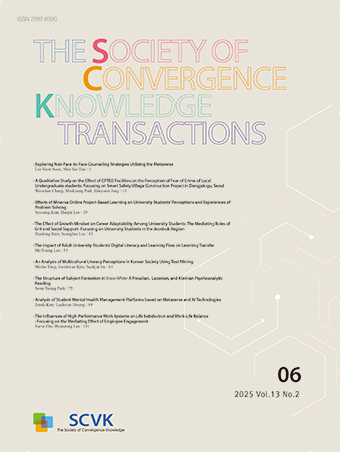Research Article
Abstract
References
Information
본 연구는 조직진단의 실무적 필요성에서 개발된 6-Box 모델을 이용하여 직무만족과의 인과관계를 밝혀보려는 시도에서 수행하였다. 또한 건설적 조직문화가 지니는 상호작용 효과를 동시에 살펴봄으로서 6-Box 변수와 조직문화 및 직무만족 간의 인과관계 분석을 시도하였다. 실증 분석 결과, 주효과 분석에서는 상사리더십과 지원제도/시스템은 그 자체만으로는 직무만족과 아무런 유의적 관련이 없었지만, 상호작용효과 분석, 즉 조직문화의 조절효과 분석에서는 조직의 문화를 건설적이라고 지각하는 기관사의 경우 상사리더십과 지원제도/시스템을 긍정적으로 지각할수록 직무만족이 증대된다는 사실을 발견하였다. 이는 6-Box의 한 가지 도메인인 상사리더십과 지원제도/시스템 차원이 건설적 조직문화와의 상호작용을 통해 직무만족에 긍정적 영향을 준다는 것을 의미하는 것으로, 이 같은 연구결과는 건설적 문화의 토대가 없으면 상사리더십과 지원제도/시스템 차원만으로는 기관사집단의 직무만족 수준을 증대시키는데 한계가 있음을 보여주는 것이다.
This study intended to highlight the causality between 6-Box model developed by the necessity for practical organizational diagnosis and job satisfaction, and also tried to analyze the causality between 6-Box variables, organizational culture and job satisfaction depicting the interaction effect as well which constructive culture has. The result of empirical analysis showed that the leadership behavior and support program/system itself had no significant relationship with job satisfaction in the main effect analysis. However, when interaction effect analysis, that is moderating effect analysis was done, it was found that when drivers perceive their organizational culture as constructive and the leadership behavior and support program/system as positive, their job satisfaction increases significantly. This means that the dimension of leadership behavior and support program/system as sub-domain of 6-Box can have positive effect on the job satisfaction through interaction with constructive organizational culture. This result implies that there will be some limitation in growing the level of driver’s job satisfaction only with leadership behavior and support program/system, if there is no basis of constructive organizational culture.
- https://www.accipio.com/eleadership/mod/wiki/view.php?id=1839
- Kontic, L., “Applying the Weisbord model as a diagnostic framework for organizational analysis”, Industrija, Vol.40, No.2, pp. 145-156, 2012.
- Lok, P., Crawford, J., “The application of a diagnostic model and surveys in organizational development”, Journal of Managerial Psychology, Vol.15, No.2, pp. 108-125, 2000.10.1108/02683940010310319
- Nebojsa, J., “Business Processes in Organizational Diagnosis, Management”, Vol.15, No.2, pp. 85-106, 2010.
- Weisbord, M. R., “Organizational diagnosis: six places to look for trouble with or without a theory”, Group Organization Management, 1, pp. 430-447, 1976.10.1177/105960117600100405
- https://titusng.com/2009/08/01/organizational-development-models-weisbords-six-box-model/
- Steers, R. M., “Organizational effectiveness : a behavioral view”, Goodyear Pub. Co., p. 103, 1977.
- 김구, “지방공무원의 직무만족과 직무성과의 영향요인에 관한 의사결정나무분석”, 한국정책학회보, 제11권 제2호, pp. 27-49, 2002.
- 김진호, “IT기업 종사자의 직무만족에 영향을 미치는 요인에 관한 연구”, 석사학위논문, 서울과학기술대학교, 2019.
- 이민규, “'1인승무' 철도기관사의 직무스트레스가 직무만족에 미치는 영향: 성격의 조절효과 검증”, 석사학위논문, 서울과학기술대학교, 2011.
- Rousseau, D. M., Cooke, R. A., “Behavioral norms and expectations: a quantitative approach to the assessment of organizational culture”, Group and Organizational Studies, Vol.13, No.3, pp. 245-273, 1988. 10.1177/105960118801300302
- http://www.businessdictionary.com/definition/organizational-culture.html.
- Ahn, K. Y., Ahn, B. D., “Modulating effect of organizational culture on the relationship between personality and incremental innovation, and the relationship between incremental innovation and service quality”, Journal of the Society of Korea Industrial and Systems Engineering, Vol.32, No.2, pp. 147-157, 2009.
- 정갑두, “개인성격과 조직효과성의 관계에 대한 조직문화의 조절효과”, 박사학위논문, 부산대학교, 2011.
- 이건혁, “직무 만족과 조직 성과의 관계 탐색: 조직 커뮤니케이션과 조직 문화의 조절 효과”, 한국콘텐츠학회논문지, 제13권 제4호, pp. 376-388, 2013.10.5392/JKCA.2013.13.04.376
- Publisher :The Society of Convergence Knowledge
- Publisher(Ko) :융복합지식학회
- Journal Title :The Society of Convergence Knowledge Transactions
- Journal Title(Ko) :융복합지식학회논문지
- Volume : 7
- No :3
- Pages :13-25
- DOI :https://doi.org/10.22716/sckt.2019.7.3.030




 The Society of Convergence Knowledge Transactions
The Society of Convergence Knowledge Transactions







